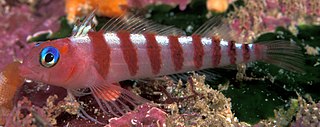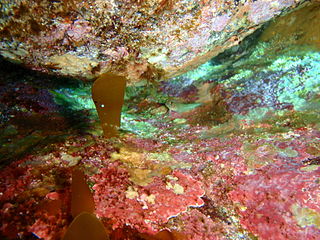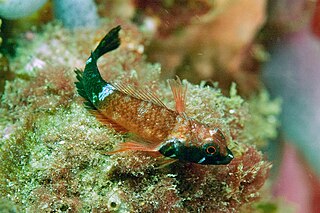
Threefin or triplefin blennies are blenniiforms, small percomorph marine fish of the family Tripterygiidae. Found in tropical and temperate waters of the Atlantic, Pacific and Indian Oceans, the family contains about 150 species in 30 genera. The family name derives from the Greek tripteros meaning "with three wings".

Ruanoho is a genus of triplefin blennies. It is known from the southwestern Pacific Ocean off New Zealand. The generic name is a compound noun derived from the Maori rua meaning either "fish" or "hole" and noho meaning to "dwell" which refers to the habit of the species in this genus to shelter under rocks or within crevices.

Forsterygion is a genus of triplefins in the family Tripterygiidae native to coastal New Zealand, but also introduced to Tasmania, Australia.

Helcogramma is a genus in the triplefin family Tripterygiidae. The blennies in the genus Helcogramma are found throughout the Indo-Pacific and in the South Atlantic Ocean off the islands of St Helena and Ascension.

Notoclinops is the name of a genus of triplefins in the family Tripterygiidae from New Zealand.

Axoclinus is a genus of triplefins in the family Tripterygiidae. This genus has sex described species. It is restricted to the eastern tropical Pacific.

Enneanectes is a genus of triplefin fish in the family Tripterygiidae.

Norfolkia is a genus of triplefins in the family Tripterygiidae. They are found I the Indo-Pacific region.

Trinorfolkia is a genus of triplefins in the family Tripterygiidae.
The yellow triplefin ,> also known as the Abel's triplefin in South Africa, is a species of triplefin in the genus Enneapterygius. Males in this species can reach a maximum length of 2.5 centimetres. The blennies are generally bright yellow in colour, and males have black heads. They feed mostly on benthic invertebrates.
Enneapterygius flavoccipitis, the yellownape triplefin or northern bicoloured triplefin, in Australia, is a species of threefin blenny in the genus Enneapterygius.
Enneapterygius pyramis, the pyramid triplefin, is a species of triplefin blenny in the genus Enneapterygius. It was described by Ronald Fricke in 1994. This species occurs in the western Pacific Ocean from Guam to French Polynesia.

Enneapterygius rufopileus, the blackcheek threefin, Lord Howe black-head triplefin or redcap triplefin, is a species of triplefin blenny in the genus Enneapterygius. It was described by Edgar Ravenswood Waite in 1904. It occurs in the western Pacific Ocean off Lord Howe Island, Norfolk Island, New Caledonia, Fiji and Tonga.
Gilloblennius abditus, known commonly as the obscure triplefin, is a species of triplefin blenny in the genus Gilloblennius. It was described by Graham Stuart Hardy in 1896. It is endemic to New Zealand where it has a disjunct distribution around North and South Islands where there are highly exposed rocky coasts.

Gilloblennius tripennis, known commonly as the thripenny, is a species of triplefin blenny in the genus Gilloblennius. It was described by Johann Reinhold Forster in 1801. It is endemic to New Zealand where its is found throughout the mainland and off the Three Kings Islands, Snares Island and Chatham Islands.
Cunningham's triplefin is a species of triplefin blenny in the genus Helcogrammoides. It was described by Frederik Adam Smitt in 1898, who named it in honour the Scottish naturalist Robert Oliver Cunningham (1841-1918), who had collected specimens of this fish from Puerto Madryn in 1868 but was unable to identify them. This species has been found in Peru, near Lima, Chile, Puerto Madryn in Argentina and the Falkland Islands.

Norfolkia brachylepis, known commonly as the tropical scaly-headed triplefin, is a species of triplefin blenny in the genus Norfolkia. It was described by Leonard Schultz in 1960. This is an Indo-Pacific species which is distributed from the Red Sea to Fiji, north to the Izu Islands and south to Australia.

Norfolkia squamiceps, known commonly as the Scalyhead triplefin, is a species of triplefin blenny in the genus Norfolkia. It was described by Allan Riverstone McCulloch and Edgar Ravenswood Waite in 1916. Under the synonym Norfolkia lairdi it was the type species of Fowler's new genus. This species has been recorded from off Queensland, Norfolk Island, Lord Howe Island, New Caledonia and the Loyalty Islands. The adults occur in tidal pools among areas of coral reef.
Norfolkia thomasi, known commonly as the Thomas' triplefin, is a species of triplefin blenny in the genus Norfolkia. It was described by Gilbert Percy Whitley in 1964, naming it in honour of Leonard Rees Thomas who organised the Australian Museum's 1962 Swain Reefs Expedition. The hemispherical eggs of the Thomas' triplefin are covered in sticky threads that help anchor them in the algae on their nesting sites. This adaption helps insure the safety of the eggs. One the eggs hatch the larvae that emerge are planktonic and they stick to shallow waters near the shore. The matured Thomas' triplefin then ventures out into the coral reef and intertidal pools. This species is found in the western Pacific Ocean from the Ryukyu Islands to the Tuamoto Archipelago, in Australia it is distributed from the northern Great Barrier Reef south to Byron Bay, New South Wales.

Trinorfolkia clarkei, known commonly as the Clarke's triplefin or Clarke's threefin, is a species of triplefin blenny in the genus Trinorfolkia. It was described by Alexander Morton in 1888 from specimens collected from Clarke Island in the Bass Strait. This species occurs I southern and western Australia from Camden Haven in New South Wales to Rottnest Island in Western Australia and around Tasmania. It occurs on coastal reefs and in estuaries frequently being observed around the pylons supporting structures such as jetties.












